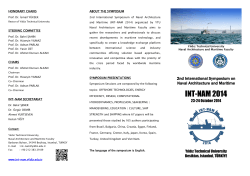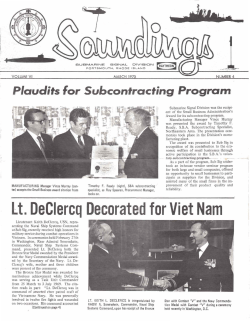
TSDM-8 Strategy US Naval War College
TSDM-8 Strategy Source: NWC Faculty edited by Dr. Coty Keller US Naval War College Relevance? “Future joint force commanders will not make grand strategy, but they must fully understand the ends it seeks to achieve. They will have a role in suggesting how the Joint Force might be used and the means necessary for the effective use of joint forces to protect the interests of the United States.” - Source: Joint Forces Command, The Joint Operating Environment 2010, p. 11. US Naval War College What is Your Definition of Strategy? US Naval War College Thoughts on Strategy “the art of the general” Strategy is the use of engagements for the object of war. – Carl von Clausewitz He who attempts to defend everything defends nothing. – Frederick the Great Strategy is the art of controlling and utilizing the resources of a nation. – Edward Mead Earle Strategy is the product of the dialogue between policy and national power. – Colin Gray US Naval War College Core Questions for the Strategist Where do we want to go or what are the desired ends? How do we achieve our ends or what are the ways? What resources are available or what are the available means? What type of risk is the country willing to assume? US Naval War College Bartlett Donut STRATEGY MEANS ENDS Ways RISK US Naval War College Intensity of Interests Vital – If unfulfilled, will have immediate consequences for core interests Important – If unfulfilled, will result in damage that will eventually affect core national interests Peripheral – If unfilled, will result in damage that is unlikely to affect core national interests US Naval War College Link Ends, Ways, and Means National Objectives (Ends) Strategic Concepts (Ways) US Naval War College National Power (Means) Identifying Ends Enduring National Interests – Ensure the security of the state and its people – Establish a stable and secure region Democratic National Interests – Promote the prosperity of the people – Encourage human security – Advance democratic institutions Product of national decision-makers – Guarantee environmental security – Promote democracy – Establish free trade zones US Naval War College The Afghanistan Strategy (ENDS) “Our overarching goal remains the same: to disrupt, dismantle, and defeat al Qaeda in Afghanistan and Pakistan, and to prevent its capacity to threaten America and our allies in the future.” • To meet that goal, we will pursue the following objectives within Afghanistan: • We must deny al Qaeda a safe haven. • We must reverse the Taliban's momentum and deny it the ability to overthrow the government. • And we must strengthen the capacity of Afghanistan's security forces and government so that they can take lead responsibility for Afghanistan's future. US Naval War College Specifying Ways How do we achieve our ends? Strategic concepts – An end-to-end stream of activities that defines how elements, systems, organizations and tactics combine to accomplish national objectives or tasks. How something might be done Consider Feasibility, Suitability, and Acceptability US Naval War College The Afghanistan Strategy (WAYS) • First, we will pursue a military strategy that will break the Taliban's momentum and increase Afghanistan's capacity over the next 18 months. - Target insurgents and protect key population centers (Marja) - Build ANSF: Karzai’s goal is for ANSF take the lead within 3-5 years - Work with allies (NATO) • Second, we will work with our partners, the United Nations, and the Afghan people to pursue a more effective civilian strategy, so that the government can take advantage of improved security. • Third, we will act with the full recognition that our success in Afghanistan is inextricably linked to our partnership with Pakistan. Committing Means “In my era, even if commanders produced good strategies at their level (and I believe we did), with good ends and reasonable ways to achieve them, we still had no idea whether or not the administration and the Congress would come through with the means.” – General Tony Zinni, former commander of US forces in the Near East, Central Asia, and East Africa US Naval War College Elements of National Power TOOLS OF NATIONAL SECURITY POLICY MILITARY INFORMATION DIPLOMATIC LEGAL Diplomatic Recognition Review Decisions of National/Multinational Legal Organizations War Public Diplomacy Nuclear Warfare Public Policy Statements Representation Public Affairs/ Press Releases Negotiation Conventional Warfare Forcible Entry Strikes/Raids Unconventional Warfare Coercion/ Compellence/ Deterrence Show of Force/ Freedom of Navigation Operations Deploy Carrier Battle Group Blockade Diplomatic Demarches Advocacy Print, Electronic and Film Information Operations Military Operations Other Than War/ Peace Support Operations Intimidation Non-Combatant Evacuation Ops (NEO) Extradition Military Deception Consensus Building Stationing and Overflight Rights Computer Network Operations Restrict Diplomatic Activities Electronic Warfare Recall Ambassador Public Affairs Operations Security Break Diplomatic Relations Embassy Draw Down/NEO/Total Evacuation Humanitarian Assistance Sct’y Assistance/ Mil-Mil Contacts Nation Building Homeland Security Military Assistance to Civil Authorities Customary International Law Coalition Building Psychological Ops Arms Control Peace Enforcement/ Peacekeeping UN Security Council Resolutions Signaling Upgrade Alert Status Overseas Presence Treaty Compliance Coordination with International Organizations and NGOs International Law Enforcement INTELLIGENCE FINANCE ECONOMIC Knowledge Fiscal Policy Trade Policy Analyzed Information Activity Collection of Information Exchange of Intelligence Information with Other States/ Multinational Orgns External Training Covert/Paramilitary Activity International Monetary Fund / World Bank Debt Forgiveness Taxes in Support of Elements of Power Borrowing for Expenditures Subsidy in Support of National Policy Freeze/Seize Monetary Assets Monetary Policy Exchange Rates Trade Promotion Trade Sanctions Trade Alliances Economic Development Embargoes Foreign Aid Technology Controls Regulation Environmental The Afghanistan Strategy (MEANS) • 30,000 additional U.S. forces (Total: 98,000 by August 2010) • ISAF includes 43 nations • ANSF: • Current Goal: 134 K (ANA) and 109 K (ANP) by Oct 2010 • “Civilian Surge” • Partners, including the UN • Pakistan US Naval War College What are the Levels of Strategy? Grand Strategy Military Strategy Theater Strategy Service Strategy US Naval War College Grand Strategy The art and science of developing and employing the instruments of national power in a synchronized and integrated fashion to achieve objectives. Strategy is about how leadership can use the power available to the state to exercise control over people, places, things, and events to achieve objectives in accordance with national interests and policies. US Naval War College Instruments of National Power Diplomatic Informational Military Economic “DIME” US Naval War College SECDEF in Kansas "We must focus our energies beyond the guns and steel of the military, beyond just our brave soldiers, sailors, marines and airmen," he said. "We must also focus our energies on the other elements of national power that will be so crucial in the years to come.“ One priority is money, Gates said. He called for "a dramatic increase in spending on the civilian instruments of national security: diplomacy, strategic communications, foreign assistance, civic action and economic reconstruction and development.“ SECDEF, Kansas State (26 Nov 2007) US Naval War College 19 Importance of Theater Strategy “Since regional problems now dominate security issues, the primary contribution towards attaining U.S. national, defense, and military strategy by the Department of Defense (DoD) is at the theater level through the combatant commander’s theater strategy.” Lt Col Clarence Bouchet, p. 1 US Naval War College Theater Strategy Concepts and courses of action directed toward securing the objectives of national and multinational policies and strategies through the synchronized and integrated employment of military forces and other instruments of national power. JP 5-0 US Naval War College Theater Security Cooperation Activity Examples Military contacts National assistance – FID, HA/DR Combined training Combined exercises Multinational education Arms control and treaty monitoring US Naval War College Levels of Strategy Grand Strategy National Policy Strategic Level Military Strategy Theater Strategy Campaigns Operational Level Theater Strategy Major Operations Battles Tactical Level Service Strategy – Advances specific strategic concepts US Naval War College Engagements Small Unit and Crew Action Risk Force Management Risks – Sustain people, equipment and infrastructure Operational Risks – Ability of the force to accomplish mission Future Challenges Risks – Investments to deal effectively with military challenges in the future Institutional Risks – Remedying inefficient processes that jeopardize the ability to use resources efficiently US Naval War College Strategy Guidance Plans PRESIDENT National Security Strategy SECDEF/CJCS National Defense and Military Strategies Guidance for Employment of the Force SECDEF Campaign Planning Guidance CJCS COMBATANT COMMANDERS *Approved by the President Contingency Planning Guidance* Nuclear Weapons Employment Guidance Joint Strategic Capabilities Plan COCOM Strategies COCOM COCOM Contingency Campaign Plans Plans SecDef Plan IPRs -----------SecDef-directed activities and IA collaboration 25 UNCLASSIFIED Consolidating Strategic Planning Process & Documents National Security Strategy (NSS) National Defense Strategy (NDS) National Military Strategy (NMS) Employ Manage Develop the Force the Force the Force Guidance for Employment Guidance for Development of the Force (GEF) of the Force (GDF) / (Now DPPG) Joint Strategic Capabilities Plan (JSCP) TransforStrategic Global Human Contingency Planning Guidance Security Cooperation Guidance Global Force Mgmt Guidance Global Posture Guidance Nuclear Weapons Planning Guidance Planning Guidance mation Planning Guidance Analytic Agenda Guidance Posture Guidance Joint Concepts & Experiment. Guidance Capital Strategy Science & Technology Guidance Unified Command Plan Global Force Mgmt (GFM) Guidance Document CJCS Risk Assessment UNCLASSIFIED Deliberative document. Draft working papers, not subject to FOIA release. UNCLASSIFIED 26 Assessment “However beautiful the strategy, you should occasionally look at the results.” Winston Churchill US Naval War College Evaluating Grand Strategy Are the desired ends appropriate? What assumptions are made about the security environment? What are the strategic priorities? STRATEGY How are tools of national power balanced? What are the means required? MEANS ENDS What impact will there be on resources? What are the perceived mismatches? What are the risks? Ways RISK What are the challenges associated with selling the strategy? US Naval War College Is Strategy a “Lost Art”? Here’s One Man’s Opinion • American strategy — strategy, the idea that in war the ways and means to carry it out should be employed considering alternatives and with the least cost of blood and treasure to achieve policy goals — is dead. The slayer of American strategy is counterinsurgency tactics. Thanks to the American Army’s embrace of counterinsurgency, what we are left with is a strategy of tactics. • Counterinsurgency has defined a new American Way of War. More than that, the doctrine of counterinsurgency has become the language and grammar of the current American war in Afghanistan. American Generals and politicians speak in the language of counterinsurgency tactics. Phrases like “protecting” or “shielding the Afghan people,” or “clear, hold, build” are all drawn from the tactics of counterinsurgency. - Source: COL Gian Gentile, “The Death of American Strategy,” Infinity Journal, Issue 3, Summer 2011 US Naval War Collegeimportant/relevant? Do you agree? Why is strategy Key Takeaways Strategy is a function of the interrelationship among ends, ways, means, and the security environment. Potential mismatches create risks. If the risks resulting from an endsways-means mismatch cannot be managed, ends must be reevaluated and scaled back, means must be increased, or the strategy must be adjusted. The strategy maker can never ignore fiscal constraints. Indeed, political reality sometimes dictates that budgetary limits will constitute the primary influence on the development of strategy and force structure. Additionally, bureaucratic and organizational imperatives play a major role in force structure choices. US Naval War College Key Takeaways (Cont) Strategy is designed to secure national interests and to attain the objectives of national policy by the application of national tools, including the military. Strategy is dynamic, changing as the factors that influence it change. As strategic requirements evolve, the strategy must also change. In practice, strategic decisions must always compete with the demands of domestic politics or what Samuel Huntington has called "structural decisions." These are choices "made in the currency of domestic politics." For the military, the most important structural decision concerns the "size and distribution of funds made available to the armed forces.... US Naval War College
© Copyright 2025














